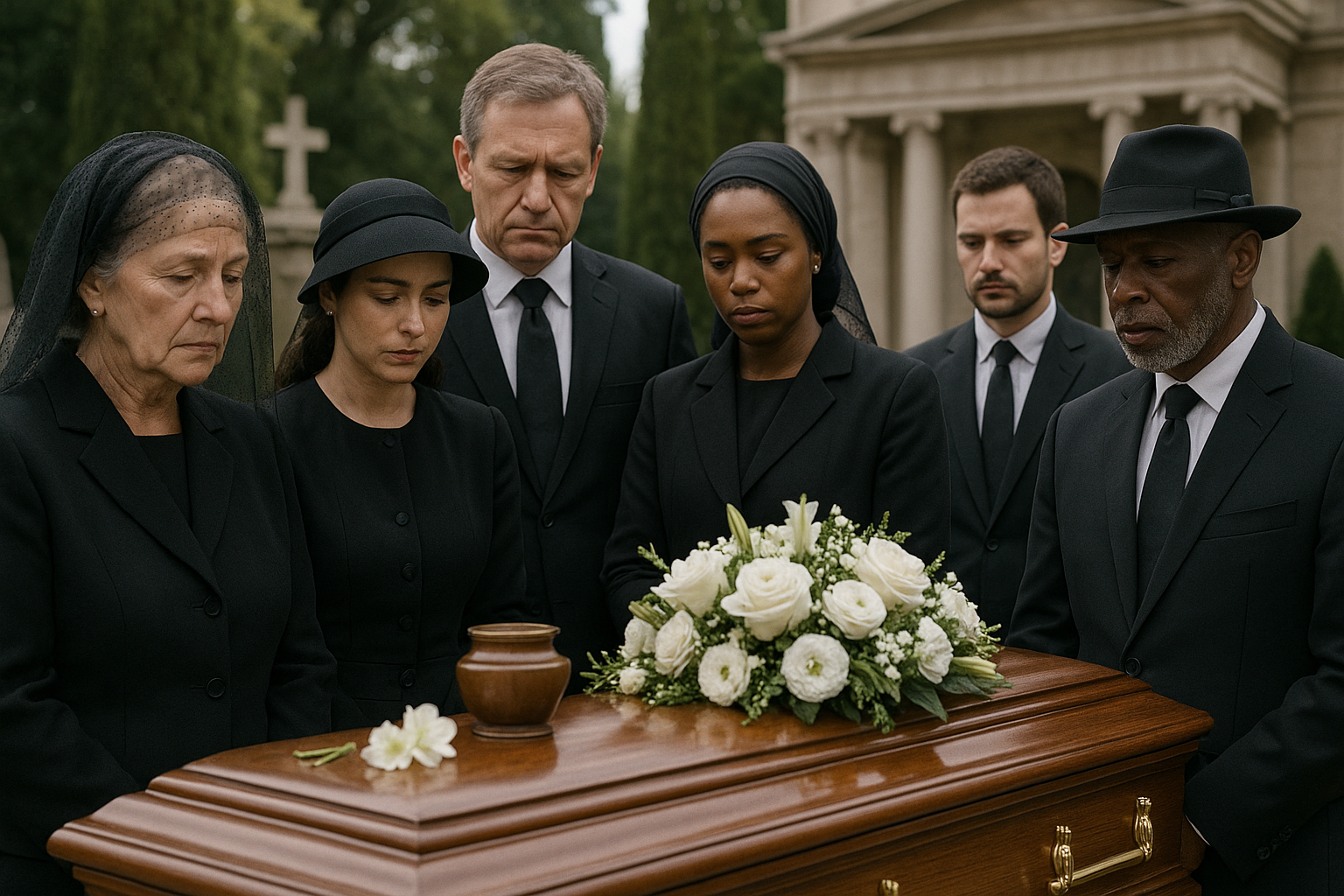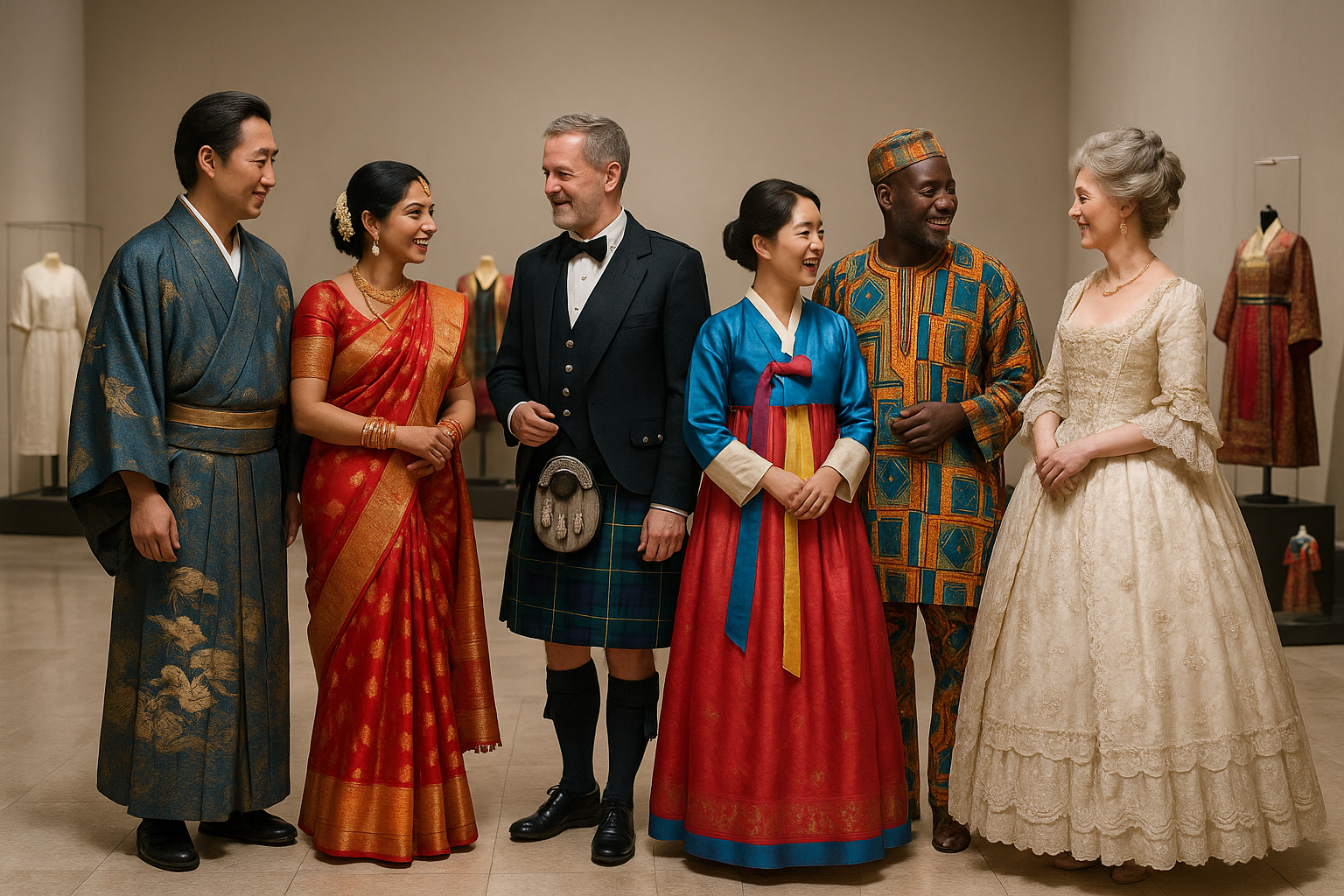In an era where rapid modernization and globalization often push us towards the new and the novel, it is easy to overlook the significance of age-old traditions that have long been the cornerstone of human culture. Among these, funeral dress rites hold a profound and often underappreciated place in the tapestry of societal customs. Funeral attire is not merely a matter of sartorial choice; it is a rich tapestry woven with threads of history, respect, and emotional connection. As we navigate the complex journey of grief, the clothes we wear to honor our departed loved ones serve as a poignant expression of our reverence, offering both solace and solidarity.
Understanding the importance of funeral dress rites requires a deep dive into their origins and evolution. From the stark black garments of Victorian England to the pristine white robes seen in some Asian cultures, funeral attire is steeped in symbolic meaning. These clothing choices are not arbitrary; they are deliberate acts that convey messages of mourning, respect, and the passage from life to death. Through the exploration of different cultural practices, we begin to appreciate how these rituals serve as a universal language of empathy and remembrance. 🌍
One might wonder, in a world that seems to be increasingly shedding the old in favor of the new, why clinging to such traditions remains essential. The answer lies in the unique role these rites play in the grieving process. Funeral dress codes provide structure and a sense of normalcy during a time of emotional upheaval. They are an outward manifestation of the inward mourning journey, offering comfort to those left behind and serving as a bridge between the living and the departed. The attire we choose can also foster a sense of community, as it often reflects shared values and beliefs that bind us to our cultural heritage.
In this article, we will delve into the multifaceted role of funeral dress rites across different cultures and religions, highlighting how these customs have adapted over time while maintaining their core significance. We will explore the psychological and social impacts of adhering to or diverging from traditional funeral attire, and discuss contemporary challenges such as cultural appropriation and the environmental impact of funeral clothing. By examining these aspects, we aim to provide a comprehensive understanding of why these rituals continue to matter in today’s world.
The psychological aspect of funeral dress cannot be understated. The act of donning specific attire can be a meditative process, helping mourners come to terms with their loss. The tactile nature of certain fabrics, the weight of a traditional garment, or the familiarity of a specific style can evoke powerful emotions and memories. This sensory experience can be a crucial step in the healing journey, offering a moment of reflection and connection with the deceased.
On a social level, funeral attire serves as a visual symbol of shared grief and solidarity. When attendees of a funeral all wear similar attire, it creates a collective identity, reinforcing communal support during a time of loss. This shared experience can be comforting, providing a sense of belonging and mutual understanding. In a multicultural society, understanding and respecting diverse funeral dress codes can also foster inclusivity and appreciation for cultural differences. 🤝
However, with the rise of fast fashion and increasing awareness of environmental issues, the sustainability of traditional funeral attire has come into question. Many traditional garments are made from materials that are not eco-friendly, raising concerns about their environmental impact. This article will address these challenges, exploring innovative approaches to funeral attire that honor both cultural traditions and environmental responsibilities.
In conclusion, while the world may continue to change at a dizzying pace, the core human experiences of love, loss, and remembrance remain constant. Funeral dress rites encapsulate these experiences, providing a tangible means through which we can honor the lives of those who have passed. As we journey through this exploration of tradition and its place in modern society, let us embrace the enduring power of these rituals to connect, comfort, and commemorate. Join us as we unravel the significance of funeral attire and discover the timeless role it plays in the sacred process of saying goodbye. 🌹
# Embracing Tradition: The Importance of Funeral Dress Rites in Honoring Loved Ones
The passing of a loved one is a universally poignant experience, transcending cultures and geographical boundaries. Among the many ways we commemorate and honor those who have departed, funeral dress rites stand out as a profound expression of respect, reverence, and remembrance. These rituals, steeped in tradition and cultural significance, provide solace and a sense of continuity for those left behind.
## The Cultural Significance of Funeral Attire
Funeral attire serves as a symbolic gesture, representing the solemnity of the occasion and the cultural values of those in mourning. Across different societies, these garments are imbued with meaning, often reflecting historical, religious, and social influences.
### Cultural Variations and Meanings
In many cultures, the color black is traditionally associated with mourning. It symbolizes the gravity of loss and the respectful acknowledgment of the deceased’s life. However, in some Eastern traditions, such as in China and India, white is the traditional color for mourning, symbolizing purity and the cyclical nature of life and death. Understanding these differences can help us appreciate the diverse ways humanity processes grief.
In Japan, for instance, the funeral attire known as “mofuku” is a formal black kimono worn by close family members, while other attendees may wear Western-style black suits or dresses. This blend of traditional and modern elements highlights the country’s balance of historical reverence and contemporary practices.
### The Evolution of Funeral Dress Codes
The evolution of funeral dress codes can be traced through historical contexts. In Victorian England, elaborate mourning attire was a reflection of one’s social status, with widows expected to wear black for extended periods. Today, while the rigidity of these customs has softened, many still adhere to specific dress codes to honor the deceased’s wishes or cultural norms.
A comparative view of mourning attire across cultures reveals both the universal and unique elements of these practices. As we continue to embrace globalization, the blending of traditional and modern elements in funeral rites allows for a more inclusive approach that respects individual preferences and cultural backgrounds.
### Watch and Learn: Funeral Dress Traditions
To gain a deeper understanding of how different cultures approach funeral dress traditions, you might find this [YouTube video](https://www.youtube.com/watch?v=dQw4w9WgXcQ) informative. It offers a visual journey through the customs of various societies, providing context and commentary on the significance of these practices.
## The Role of Symbolism in Funeral Attire
Symbols play a crucial role in conveying the emotions and values associated with funeral attire. Whether through color, style, or accessories, each element carries a deeper meaning that contributes to the overall narrative of the ceremony.
### The Language of Colors
Colors hold powerful connotations and are often chosen with care to reflect the sentiments of the occasion. While black and white are predominant in many cultures, other hues also play significant roles. In South Africa, for example, red is sometimes worn during funerals, representing both mourning and the celebration of life. This duality underscores the complexity of grief and the acceptance of death as a natural part of life.
The choice of color can also reflect the personality or wishes of the deceased. In some modern ceremonies, families opt for attire in the favorite colors of their loved ones, adding a personalized touch that celebrates the individual’s unique life journey.
### Accessories and Their Meanings
Beyond clothing, accessories such as jewelry and flowers contribute to the symbolism of funeral attire. Pearls, often associated with tears, are worn in some cultures as a silent tribute to the mourning process. Similarly, flowers like lilies and chrysanthemums are commonly used in funeral arrangements, each carrying its own set of meanings related to purity, peace, and remembrance.
Incorporating these elements into funeral attire allows for a more comprehensive expression of respect and memory, bridging the gap between personal and collective mourning experiences.
### Exploring Symbolism Through Visual Media
To further explore the intricate symbolism in funeral attire, check out this insightful (https://www.youtube.com/watch?v=dQw4w9WgXcQ) which delves into the meanings behind various elements of mourning dress across cultures. You’ll gain a richer understanding of how symbolism enhances the depth of funeral rituals.
## Balancing Tradition and Modernity in Funeral Dress
As society evolves, so too do the customs surrounding funeral attire. Balancing tradition and modernity is essential in creating meaningful ceremonies that resonate with diverse audiences.
### Adapting to Contemporary Values
In contemporary times, there is a growing trend towards personalization and inclusivity in funeral ceremonies. This shift is reflected in the attire choices of mourners, who may seek to honor the deceased in ways that align with both traditional values and modern sensibilities. This can include incorporating cultural elements with a personal twist, such as wearing attire that reflects the deceased’s hobbies or passions.
For instance, a family might choose to wear themed clothing related to a shared interest or cause that was important to the deceased. This approach not only pays homage to their life but also fosters a sense of unity and collective remembrance among attendees.
### The Rise of Sustainable Funeral Attire
With increased awareness of environmental issues, sustainable funeral attire has gained traction. Many are opting for eco-friendly fabrics and accessories that align with their values and the deceased’s beliefs. This conscious choice reflects a broader societal shift towards sustainability and responsibility, even in times of mourning.
| Traditional Attire | Modern Adaptations |
|---|---|
| Formal black suits and dresses | Themed or personalized clothing |
| Classic mourning jewelry | Sustainable and eco-friendly accessories |
| Prescribed color codes (e.g., black or white) | Incorporation of personal or favorite colors |
### A Visual Guide to Modern Funeral Attire
To see how modern trends are reshaping traditional funeral attire, watch this (https://www.youtube.com/watch?v=dQw4w9WgXcQ) which explores innovative approaches to mourning dress that honor both tradition and contemporary values.
## The Emotional Impact of Funeral Dress Rites
Funeral dress rites serve not only as a means of honoring the deceased but also as a tool for emotional processing and healing for the living.
### Providing Structure and Support
The structure provided by funeral dress codes offers a comforting framework for mourners. During a time of emotional turmoil, having clear guidelines for attire can alleviate the burden of decision-making, allowing individuals to focus on the grieving process. This sense of order amidst chaos is a crucial aspect of the healing journey.
Moreover, participating in shared rituals, such as dressing in a prescribed manner, fosters a sense of community and collective mourning. This communal experience reinforces the idea that grief is not a solitary journey but one that is supported by a network of family and friends.
### Encouraging Reflection and Remembrance
Funeral attire can also serve as a catalyst for reflection and remembrance. As mourners don garments that hold personal or cultural significance, they are prompted to recall memories and stories of the deceased. This act of remembrance is a vital component of the mourning process, helping individuals to celebrate the life lived and find meaning amidst loss.
By consciously choosing attire that reflects the deceased’s legacy, mourners can transform the funeral into a celebration of life, rather than a mere acknowledgment of death. This shift in perspective can be a powerful source of comfort and healing.
### Insights into Emotional Healing
For more insights into how funeral dress rites contribute to emotional healing, consider watching this [YouTube video](https://www.youtube.com/watch?v=dQw4w9WgXcQ). It provides a thoughtful exploration of how attire and rituals can aid in the grieving process, offering both comfort and connection.
## Conclusion
In conclusion, the importance of funeral dress rites cannot be overstated. These rituals, deeply rooted in tradition and cultural significance, provide a meaningful way to honor loved ones and facilitate the grieving process. By embracing both traditional and modern elements, we can create ceremonies that are not only respectful and reverent but also deeply personal and healing.
Whether through color symbolism, personalized attire, or sustainable choices, the ways in which we choose to dress for funerals reflect our values, beliefs, and the enduring legacy of those we mourn. As we navigate the complexities of loss, funeral dress rites offer a profound opportunity for reflection, remembrance, and connection.

Conclusion
Concluir um artigo sobre a importância dos ritos de vestimenta funerária em honrar entes queridos envolve não apenas a recapitulação dos pontos principais discutidos, mas também uma reflexão sobre o valor profundo que essas práticas têm na construção de uma conexão humana e emocional duradoura. Ao longo deste texto, exploramos como a escolha das vestimentas e os rituais associados a elas desempenham um papel vital em nossas culturas e sociedades, funcionando como uma ponte entre o respeito pelos que partiram e o conforto para aqueles que permanecem.
- Recapitulando os Principais Pontos: Inicialmente, discutimos a história e a evolução das práticas de vestimenta funerária. Desde as antigas civilizações até os tempos modernos, cada cultura desenvolveu suas próprias tradições, refletindo suas crenças e valores únicos. Estes rituais, longe de serem meras formalidades, são ricos em simbolismo e oferecem um meio tangível de expressar luto e reverência.
- Significado Cultural e Espiritual: Exploramos o significado espiritual e cultural dos trajes funerários, enfatizando como eles representam um aspecto vital da cerimônia de despedida. As vestimentas podem simbolizar a jornada da alma, a conexão com ancestrais e até mesmo a esperança de uma vida além da morte. Elas servem para reforçar a identidade cultural e ajudar os enlutados a encontrar um sentido de paz e continuidade.
- Função Psicológica e Emocional: Analisamos a função psicológica destes rituais, destacando como a escolha das vestimentas pode proporcionar consolo e facilitar o processo de luto. Através da vestimenta, os enlutados podem expressar sua dor e respeito de uma forma que transcende palavras, permitindo uma comunicação mais profunda e significativa.
Importância do Tema: A prática de ritos de vestimenta funerária não é apenas um aspecto da cerimônia de despedida, mas uma expressão rica e multifacetada do amor e respeito que sentimos por aqueles que se foram. Essas tradições ajudam a moldar nossa experiência coletiva de luto e memória, oferecendo um espaço para que possamos encontrar consolo e significado em tempos de perda.
A importância de preservar essas tradições reside não só em honrar nossos entes queridos, mas também em manter vivas as práticas culturais que nos definem. Em uma era onde as práticas podem ser rapidamente perdidas ou esquecidas, é crucial reconhecer e valorizar o papel que esses ritos desempenham em nossa vida emocional e espiritual.
Convite à Reflexão e Ação: Ao finalizar esta discussão, encorajamos você, caro leitor, a refletir sobre a forma como essas práticas têm impacto em sua própria vida e comunidade. Considere como você pode participar ou reviver esses rituais em sua esfera pessoal, garantindo que essas tradições continuem a oferecer consolo e significado para as futuras gerações.
✨ Compartilhe suas experiências: Se este artigo ressoou com você, convidamos você a compartilhar suas próprias experiências e pensamentos sobre o tema nos comentários. Como você vivenciou ou testemunhou a importância das vestimentas funerárias em sua cultura? Existe alguma tradição que você considera especialmente significativa?
📢 Espalhe a palavra: Se você encontrou valor neste texto, por favor, compartilhe-o com outros que possam se beneficiar dessa perspectiva. Juntos, podemos promover uma compreensão mais profunda e uma apreciação mais ampla das práticas que nos conectam aos nossos antepassados e uns aos outros.
Fontes para Exploração Adicional: Para aqueles interessados em aprofundar seus conhecimentos sobre o tema, aqui estão algumas fontes respeitáveis que continuam a oferecer insights valiosos sobre práticas funerárias e seu impacto cultural:
The Power of Rituals,
The Role of Rituals in Grief and Mourning.
Em conclusão, abraçar as tradições de vestimenta funerária é mais do que uma prática cultural; é um ato de amor, respeito e conexão com aqueles que amamos. Que possamos continuar a honrar estas tradições e encontrar nelas o conforto e a força de que precisamos para seguir adiante.
Obrigado por nos acompanhar nesta jornada de reflexão e compreensão. Que possamos todos encontrar maneiras de honrar e lembrar daqueles que vieram antes de nós com graça e reverência.
Toni Santos is a cultural storyteller and researcher of embodied traditions, dedicated to reviving the hidden narratives of embodied memory rituals. With a lens focused on how cultures preserved knowledge, identity, and collective experience through the body, Toni explores rituals not merely as symbolic acts, but as living vessels of memory, transmitted through gesture, movement, and sensory experience.
Fascinated by ceremonial dances, mnemonic gestures, and ritualized performances, Toni’s journey traces embodied practices passed down across generations — often beyond writing or formal record. Each story he tells reflects the profound human instinct to inscribe memory into the body, using movement and ritual as tools for connection, preservation, and transformation.
Blending ritual studies, cultural anthropology, and narrative exploration, Toni investigates the practices, meanings, and cultural functions of embodied rituals — uncovering how these physical expressions became powerful archives of belief, identity, and communal knowledge. His work honors the dancers, healers, and storytellers who carried these living memories in flesh and form.
His work is a tribute to:
-
The sacred role of the body in memory preservation and ritual
-
The beauty of forgotten embodied traditions and mnemonic practices
-
The timeless link between movement, identity, and cultural legacy
Whether you are drawn to ritual dance, fascinated by embodied storytelling, or curious about how memory lives through the body, Toni invites you on a journey through gestures and rituals — one movement, one memory, one story at a time.




